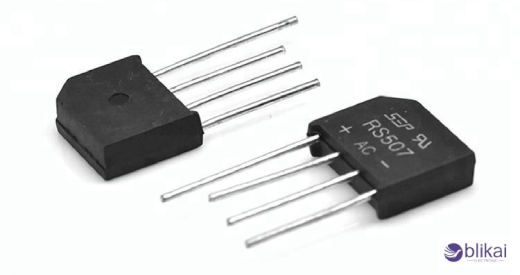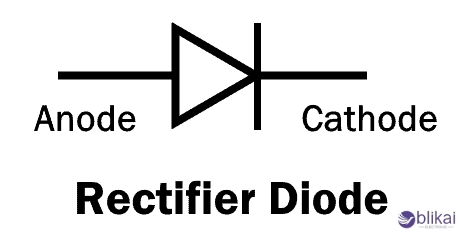What is a Rectifier Diode and How Does it Work?
What is a Rectifier Diode?
A rectifier diode is a specialized electronic device that permits the flow of electric current only in one direction while restricting it from flowing in the opposite direction. This inherent property gives rectifier diodes immense significance in transforming alternating current into direct current. The basic function of a rectifier diode is to "rectify" or smooth out the alternating current, so electricity always flows in one direction.

Types of Rectifier Diodes
There are several types of rectifier diodes, each tailored for specific applications:
- General-purpose rectifiers: Suitable for Low to Medium Power Applications
- Fast recovery rectifiers: Designed for high-frequency switching
- Schottky rectifiers: Known for Low Forward Voltage Losses and Fast Switching
- Bridge rectifiers: Where In a Single Housing, Four Diodes for Complete Wave Rectification
Key Components and Structure
The structure of a rectifier diode consists of two primary components:
- Cathode: The negatively charged terminal
- Anode: Positively charged
The diodes are made with semiconductor materials, frequently silicon, and are protected with an outer covering. The junction of the diode comprises the cathode and anode; the junction creates a depletion zone that gives diode its rectifying property. When sufficiently biased, electrons flow from the cathode to the anode and pass through the rectifier in the forward direction.

How Rectifier Diodes Work
The rectification process explained
Bridge rectifier is the classical electronic component converting alternating current (AC) to direct current (DC). Such devices allow the rectification to occur by their unique property of conducting switch only in one direction. With the AC voltage fulminating between positive and negative potential, the rectifier conducts current during the positively charged half-cycles and completely blocks it during the negative half-cycle.
Forward and reverse bias
In a forward direction, current flows from the anode to the cathode through a diode; a higher voltage at the anode than at the cathode is said to be progressive. Conversely, when the voltage at the anode is less than that on the cathode, reverse bias prevents the current from flowing through the diode, like with an open circuit.
Voltage drop across the diode
A forward-biased rectifier diode has a small voltage drop across its terminals when it conducts. This voltage drop is 0.7-volt and 0.3-volts for silicon and germanium diodes, respectively. This feature is important in circuit design since it determines the efficiency and power dissipation ratio of the whole rectification process.
Current flow direction
In the case of a rectifier diode forward-biased anode to cathode, the current always flows in that same direction, consequently, a transformation of AC to pulsating DC because of unidirectional current flow is possible. The resulting output can then be smoothed using additional components like capacitors to produce a more stable DC voltage.
Applications of Rectifier Diodes
Power supplies and AC to DC conversion
Rectifier diodes are an intrinsic part of power supplies in the rectification of AC power into DC power. This process of rectification is a significant application since most electronic devices function on DC voltage. Rectifier diodes are usually connected into a bridge configuration within a power supply to convert the AC input taken from wall outlets into a pulsating DC output, which is thereafter smoothed and regulated.
Signal demodulation in radio receivers
Radio receivers use rectifier diodes for the demodulation of the original audio signal from the modulated radio frequency of the carrier wave. This is a principal operation in AM (Amplitude Modulation) radio reception, during which the diode removes the high-frequency carrier wave to leave only the desired high-frequency audio signal.
Protection against reverse polarity
Rectifier diodes are often employed as protection devices in electronic circuits. When connected in series with the power input, they prevent damage from accidental reverse polarity connections by blocking current flow in the reverse direction. This application is particularly useful in battery-operated devices and automotive electronics.
Solar panel systems
Rectifier diodes are fundamental appliances for various solar energy systems. They protect against that unwanted reverse current from battery to solar panel during low light and night hours. This process, known as blocking, prevents the stored energy in batteries from being dissipated into solar panels due to non-generation of power from electric discharge properties.
Battery charging circuits
The charging of batteries relies on rectifier diodes to prevent such devices from discharging through the charging circuit. When the power source is disconnected or does not actively charge, this becomes one of the most critical applications for maintaining battery charge and prolonging battery life of devices from mobile phones right up to electric fridges.
Advantages of Rectifier Diodes
Efficiency in power conversion
Rectifier diodes convert AC to DC with little loss of energy. Such high efficiency makes them invaluable in power supply systems, placing emphasis on effective utilization of maximum electric energy.
Simplicity and reliability
Rectifier diodes have a simple design, with no moving parts. Therefore, since these are solid-state and very reliable, rectifier diodes are long-lived devices. Their simpler designs also mean fewer points of failure, hence robust and reliable performance for long durations.
Cost-effectiveness
The simple design and widespread usage of rectifier diodes mean these are cheaper to manufacture. This cost-effective feature makes it one of the preferred appliances in various applications.
Wide range of current and voltage ratings
Rectifier diodes are available in a plethora of current and voltage ratings, allowing the engineer more options for diode selection depending on the power requirement of the application, from low-power consumer electronics to high-power industrial systems.
Limitations and Considerations
Power dissipation and heat generation
Rectifier diodes, while efficient, are not perfect devices. The foremost of their limitations occurs in power dissipation: this results in heating. A slight resistance to the current passing through the diode does exist, and this is what causes it to yield a small amount of heat energy which can lower the performance and lifespan of the diode (should it become excessive). For high-power applications-the use of heat sinks or suitable cooling systems is necessary to keep the LLC within limits.
Voltage limitations
Each rectifier diode has a peak inverse voltage, or the maximum reverse voltage that can be withstood. When selecting a diode for a specific application, PIV is very important because if this reverse voltage is exceeded, reverse breakdown can occur. This can cause damage to the diode and to the circuit it is protecting. Since selection of diodes is generally critical for engineers, they must give careful consideration to expected voltage levels.
Reverse recovery time
Reverse recovery time is another important consideration when working with rectifier diodes. This refers to the time taken by the diode to switch from conducting to non-conducting. During this period, albeit very brief, the diode permits current to flow in the reverse direction. Such reverse current, when allowed, can lead to power losses and results in interference. Fast recovery diodes offer this in case it really matters in applications, but these come at a cost.
Temperature sensitivity
Rectifier diodes are temperature-sensitive devices that are engineered for performance and reliability. As temperature rises, the forward voltage drop typically lessens in the diode, leading to increased current flow and more heat generation. Conversely, extremely low temperatures can increase the forward voltage drop, reducing efficiency. Designers must account for the expected operating temperature range and choose diodes that can maintain stable performance under these conditions.
Selecting the Right Rectifier Diode
Understanding diode specifications
In choosing rectifier diodes, one would understand certain specifications, including the maximum reverse voltage, forward current rating, and reverse recovery time. The maximum reverse voltage refers to the capability of the diode of withstanding a voltage highly in reverse polarity. The forward current rating, on the other hand, indicates the maximum current that can be allowed on the forward side of the diode. Reverse recovery time broadly affects the switching speed of the diode. This is especially critical in applications that require high frequency.
Matching diodes to circuit requirements
To choose the right rectifier diode, carefully analyze your circuit's requirements. Consider the expected voltage and current levels, operating frequency, and any specific performance needs. Schottky diodes, for example, are perfect for low-voltage, high-frequency applications, while silicon diodes would require a higher voltage scenario.
Considering environmental factors
Environmental conditions play a significant role in diode selection. Temperature, humidity, and any other kind of mechanical stress will all come up to influence diode performance and lifespan. Diodes should be chosen for temperature ratings and packaging suitable for the expected environment of operation. For harsh conditions, consider diodes with robust encapsulation or special coatings.
Cost vs. performance trade-offs
The optimal trade-off between cost and performance is an extremely important factor to be considered in rectifier diode selection. The performance-oriented diodes exhibit some exceptional characteristics along with a corresponding inflation in price. Determine the budget constraints and specific application requirements to find the most economical solution. Sometimes it is meagerly cheaper to use a number of low-performance diodes in parallel than a single high-one.
Related Articles
Complete Guide to 1N4148 Diode Specifications
What is a 1N4007 Diode and How Is It Used in Circuits?
What is 1N4732A Zener Diode: Features and Its Working
Bridge Rectifier: Construction, Working, and Applications
Understanding Rectifiers: How Do They Convert AC to DC?
2P4M Silicon Controlled Rectifier (SCR): Pinout and Application
Diode:Construction,Types & Working
What 1N5408 Power Diode is : Pinout & Applications
BAT54A Schottky Diode:Application,Features and Pinout
1N4001 Diode: Pin Configuration, Features, and Applications
BAT54A Diode: Pin Configuration & Applications
1N4148 Diode: Features and its Applications
What is 1N4732A Zener Diode: Features and Its Working
What is a 1N4007 Diode and How Is It Used in Circuits?
Complete Guide to 1N4148 Diode Specifications
Do ECM Motors Have Capacitors?










